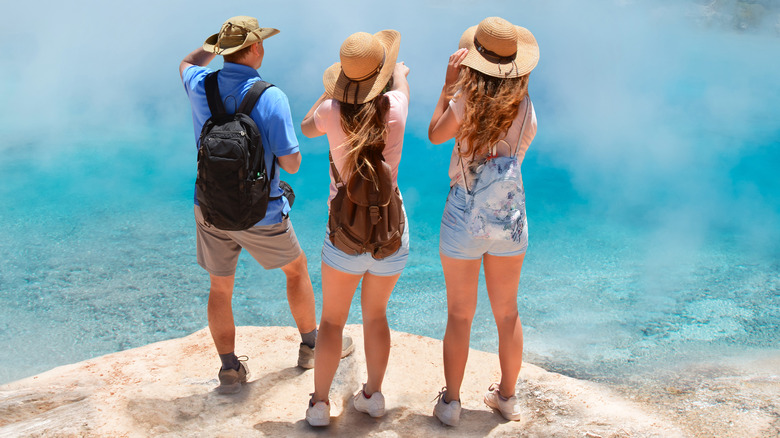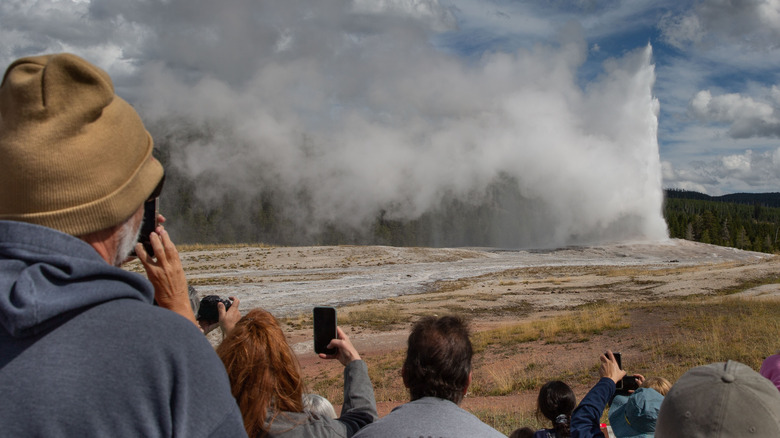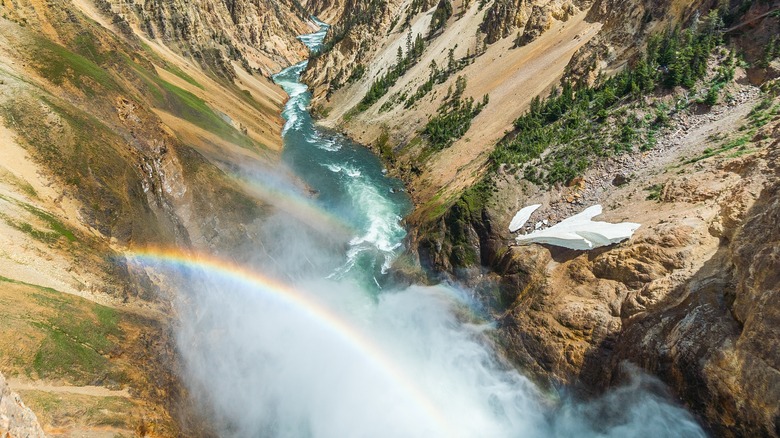What Would Happen If Yellowstone Erupted?
Millions of people visit Yellowstone National Park each year for awe-inspiring sights like the Old Faithful geyser. Attractions like Old Faithful only exist, though, because Yellowstone sits on top of an active supervolcano, a ticking geological time bomb that has erupted three times in the past 2.1 million years, according to the U.S. Geological Survey (USGS). But where there's been an eruption, there's the chance there could be one again. How likely is it, then, that the supervolcano under Yellowstone might blow its top, leading to a super-eruption, and how bad would it be?
As the USGS explains, the Yellowstone supervolcano might erupt soon. Well, soonish from a geological perspective — sometime in the next couple of thousand years. Geologists at USGS classify supervolcanoes — such as what's underneath Yellowstone — as a volcanic center with past eruptions covering at least 240 cubic miles. Meanwhile, super-eruptions from supervolcanoes are defined as any eruption of at least magnitude 8 on the Volcano Explosivity Index, Vox explains. Yellowstone is just one of two supervolcanoes located in the U.S. — the other can be found in California's Long Valley.
Even though the Yellowstone supervolcano could spew lava, the USGS assigns a minuscule — or 0.00014 % — chance of it happening. As it stands, there are better odds the world will end from a planet-destroying asteroid. In other words, with odds of only 1 in 730,000 the supervolcano might blow, there's no reason to cancel your Yellowstone travel plans. What might happen should such a thing occur, though, is still a fascinating thing to consider.
A Yellowstone eruption would affect the the global climate for decades
Even though there's a very small, almost nonexistent chance the supervolcano under Yellowstone might erupt, it's still possible. Should the Yellowstone supervolcano blow up, the USGS says that it would likely affect the global climate for decades. In the aftermath, surrounding states like Montana, Idaho, and most of Wyoming would experience pyroclastic flows — also known as molten lava — along with falling molten rock.
But far more deadly would be the molten ash cloud, choking everything including much of the American Midwest with a thick blanket of ash. Under that ash, crops, and livestock would suffer, and as a result, the food supply would diminish. Elsewhere, our streams and rivers would become temporarily clogged, causing a number of related ecological side effects.
The eruption would also cause a caldera to form — a depressed area of land possibly miles wide as the explosion removes the magma or molten rock from deep below. In the aftermath, sulfur dioxide would be released into the atmosphere — a trigger for global cooling — which would further affect the worldwide crop supply. While a Yellowstone eruption would definitely be a cause for concern, it would be unlikely to cause human extinction. And as the USGS points out, the unlikely eruption would be predicted months if not years in advance, allowing for proper preparation and damage mitigation.
The Yellowstone area is closely monitored
Though there's next to no chance the Yellowstone supervolcano might erupt in the next couple thousand years, the area is still closely monitored just to make sure. This chiefly takes place via the Yellowstone Volcano Observatory (YVO), operated in collaboration with the USGS, the national park itself, and the University of Utah. Through the YVO website, it's possible to get real-time information on everything from stream flow and water temperature to earthquake chances.
Volcanic eruptions aside, there are far more common risks at Yellowstone to consider, such as hydrothermal explosions from a geyser possibly caused by a number of geologic forces (which are still rare). Among the most recent examples is the magnitude 6.1 quake near Norris Geyser Basin in 1975.
In 2014, a team of scientists published a paper on the Geochemistry, Geophysics, Geosystems that studied the long-term effects of a Yellowstone super-eruption. As Jacob Lowenstern of the U.S. Geological Survey and Scientist-In-Charge of the YVO, who co-authored the study, told Vox: "Even if Yellowstone did erupt again, you probably wouldn't get that worst-case scenario," he said. According to Lowenstern, "small eruptions" — though still rare — are "much, much more common." He added: "That's a point that often gets ignored in the press."
The last eruption at Yellowstone, which happened around 70,000 years ago, caused a relatively benign lava flow at Pitchstone Plateau. "The Earth will see super-eruptions in the future, but will they come in Yellowstone? That's not a sure thing," Lowenstern said (via Vox). "Yellowstone's already lived a good long life. It may not even see a fourth eruption."


